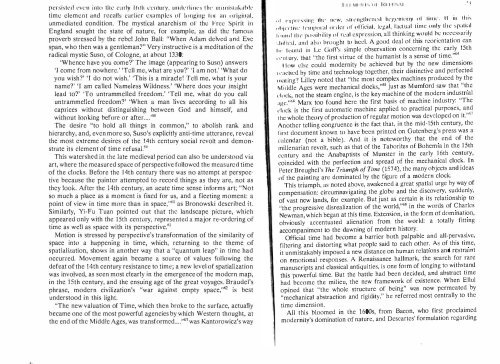CONTENTS - ouroboros ponderosa
CONTENTS - ouroboros ponderosa
CONTENTS - ouroboros ponderosa
Create successful ePaper yourself
Turn your PDF publications into a flip-book with our unique Google optimized e-Paper software.
ersislcd I'Vl' ll illio Ihe carly Illlh lTlllury, 1IIIlIn lill'" Illl' "llIliislaah'"<br />
lime clement and recalls earlier e xamrles of longing for all origi"al,<br />
unmediated condition, The mystical anarchism of the Free Sririt ill<br />
England sought the state of nature, for examp le, as did the famolls<br />
proverb stressed hy the rebel John Ball: "When Adam delved and Eve<br />
span, who then was a gentleman?" Very instructive is a meditation of the<br />
radical mystic Suso, of Cologne, at about 1330:<br />
'Whence have you come?' The image (appearing to Suso) answers<br />
'1 come from nowhere.' 'Tell me, what are you?' '.I am not.' 'What do<br />
you wish?' ') do not wish.' 'This is a miracle! Tell me, what is your<br />
name?' ') am called Nameless Wildness.' 'Where docs your insight<br />
lead to?' 'To untrammelled freedom.' 'Tell me, what do you call<br />
un trammelled freedom?' 'When a man lives according to all his<br />
caprices without distinguishing between God and himself, and<br />
without looking before or afteL .. .'"<br />
The desire "to hold all things in common," to abolish rank and<br />
hierarchy, and, even more so, Suso's explicitly anti-time utterance, reveal<br />
the most extreme desires of the 14th century social revolt and demon<br />
strate its element of time refusaL"<br />
This watershed in the latc medieval period can also be understood via<br />
art, where the measured space of perspective followed the measure d time<br />
of the clocks, Before the 14th century there was no attempt at perspec<br />
tive because the painter attempted to record things as they are, not as<br />
they look. After the 14th century, an acute time sense informs art; "Not<br />
so much a place as a moment is fixed for us, and a 11et:ting moment: a<br />
point of view in time more than in space, ,,60 as Bronowski described it.<br />
Similarly, Yi-Fu Tuan pointed out that the landscape picrure, which<br />
appeared only with the 15th century, represented a major re-ordering of<br />
time as well as space with its perspective,"<br />
Motion is stressed by perspective's transformation of the similarity of<br />
space into a happening in time, which, returning to the theme of<br />
spatialization, shows in another way that a "quantum leap" in time had<br />
occurred, Movement again became a source of values following the<br />
defeat of the 14th century resistance to time; a new level of spatialization<br />
was involved, as seen most clearly in the emergence of the modern map,<br />
in the 15th century, and the ensuing age of the great voyages, Braudel's<br />
phrase, modern civilization's "war against empty space,, , 6! is best<br />
understood in this light<br />
"The new valuation of Time, which then hroke to the surface, actually<br />
became one of the most powerful agencies by which Western thought, at<br />
the end of the Middle Ages, was transformed .. ,,"" was Kantorowicz's way<br />
,d t" pl \'ssilll'. thl' lIew, slrcliglilcl1l"d hl'J.-',l'lIIony or lillil', If ill 11,1 is<br />
" hl(Tlivl' klllp()r;11 order oj" official, legal. faclual l ime (lilly the spallal<br />
,<br />
1" lIl1d llie possihility of n.:al expression, all thinking would he necessarily<br />
',Ioilled, and aiso "roughl to heeL A good deal of this reorientation can<br />
I ... Ii''''lli in Le Goffs simple observation concerning thc carly 15th<br />
"" llluI'V, that "the first virtuc of the humanist is a sense of time,"'"<br />
11m: else could modernity be achieved but by the new dimensions<br />
It'ached by time and technology together, their distinctive and perfected<br />
Ilialing') Lillcy noted that "thc most complex machines produced by the<br />
Middle Ages were mechanical clocks,"" just as M umford saw that "the<br />
dock not the steam engine, is the key machine of the modern mdusmal<br />
ae,";" Marx too found here the first basi s of machine industry: "The<br />
dock is thc first automatic machinc applied to practical purposes, and<br />
I he whole theory of production of regular motion was dcvelopcd on it.',67<br />
Anothcr tellino congruence is the fact that, in the mid-15th century, the<br />
o<br />
b '<br />
first document known to have been printed on Guten erg s press was a<br />
calendar (not a bible), And it is noteworthy that the e , nd of the<br />
millenarian revolt, such as that of the Tabontes of Bohemia In the 15th<br />
century and the Anabaptists of Munster in the early 16th century,<br />
coincided with the perfection and spread of the mechamcal clock, In<br />
Peter Breughcl's The Triumph of Time (1574), the many Objects and idea,<br />
of the painting are dominated by the figure of a modern clock,<br />
This triumph, as noted above, awakened a great spatIal urge by way of<br />
compensation: circumnavigating the globe and the discovery" sudd nly,<br />
of vast ncw lands, for example, But just as certain IS Its relatIOnship to<br />
"the progressive disrealization of the world,"" in th words of Charles<br />
Newman, which began at this time, Extension, in the form of domln lton,<br />
obviously accentuated alienation from the world: a totally fitting<br />
accompaniment to the dawning of modern history,<br />
Official time had become a barrier both palpable and all-pervaSive,<br />
filtering and distorting what people said to each other. As of this time,<br />
it unmistakably imposed a new distance on human relatIons and restramt<br />
on emotional responses, A Renaissance hallmark, the search for rare<br />
manuscripts and classical antiquities, is one form of longing to withstand<br />
this powerful time, But the battle had been decided, and abstract tIme<br />
had bccome the milieu, the new framework of existence, When Ellul<br />
opined that "the whole structure of being" was now permeated by<br />
"mechanical abstraction and rigidity," he referred most centrally to the<br />
time dimension,<br />
All this bloomed in the 1600s, from Bacon, who first proclaimed<br />
modernity's domination of nature, and Descartes' formulation regarding<br />
, I<br />
,






